
WatchdogRI.org March 10, 2015
The intent of this research is to provide a foundation on which to have a statewide conversation about fire protection in Rhode Island. This research is not intended to provide a solution to any problem. It is intended to provide the insight necessary to have a discussion about what a solution might be.
The data portrayed and described in this presentation of Rhode Island fire protection is mostly found in the public domain. A fire survey was sent to every fire organization in the state. These organizations run the range from municipal fire departments (like Providence, Warwick and Cranston) to fire districts (like Central Coventry, Albion and Cumberland) to volunteer fire companies (like Exter #1, Lake Mishnock and Kingston).
The survey asked for financial and operational data for each organization, including budgets, apparatus, stations, contracts (if applicable), staffing and call-related data.
There was good cooperation on the part of many fire organizations in responding to the survey. We have full data sets from every municipal fire department in the state.
A surprising number of volunteer fire companies failed to respond to the survey in any way, and one (the Prudence Island Volunteer Fire Company) challenged whether Rhode Island's Access to Public Records Act (APRA) applied to volunteer firefighting companies. We believe that RI law is clear that APRA does apply to volunteer firefighting companies, and we have filed a complaint against the Prudence Island Volunteer Fire Company with the Attorney General's office, with complaints against the other volunteer departments to follow.
Several fire districts also failed to respond to the fire survey – and fire districts are specifically listed as organizations that must comply with APRA. A complaint has been filed against the Ashaway Fire District and the Pascoag Fire District, with complaints against a few other fire districts to follow.
While the data is not complete in terms of survey responses from some fire organizations, we were able to back fill a lot of the data we needed using data provided by the Auditor General's office. Under a recent RI State law, fire districts and volunteer fire companies are now compelled to file financial reporting with the Auditor General. Apparatus and some station information for the missing survey responses were found online.
Municipal budgets were used to cross check some figures in survey responses and to provide some idea of the financials of volunteer departments which did not reply to the survey. It was not easy to find electronic versions of every town's budget - and in fact Johnston's budget is nowhere to be found online.
Information on unfunded pension liabilities was found in audited financial statements which we found on every town's website.
Total population counts are close estimates and not exact. Some organizations reported counts at odds with census data, and we did not have the ability to arbitrate those differences. Also, some of the unfunded pension liability data had to be estimated because some towns did not itemize police versus fire pension liabilities – they were lumped together.
There is much more data available than what is presented below. This is a first pass at presenting the highest level issues. Additional data releases will follow.
The interactive map below of Rhode Island's 158 fire stations was created by matching up fire station information reported in the fire surveys with GIS data in Rhode Island's E911 database. You can click on individual fire station markers and see data specific to that station. We are working on a more complete database of call data by station.
This map shows all the fire stations in Rhode Island.
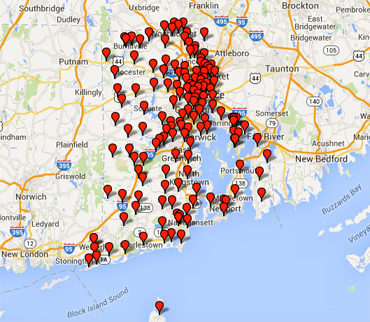
Rhode Island's 158 fire stations surpasses the number of stations in Los Angeles - 106 - and in Chicago - 92. Many of the fire stations found in Rhode Island today were sited back when fire engines were pulled by horses. These stations were often placed near mills, most of which either no longer exist or are no longer functioning.
The interactive map below of Lincoln, RI's 7 fire stations illustrates the idea of mill-based fire stations. Lincoln has 21,000 people living in about 19 square miles. Lincoln has 6 fire districts each with its own chief, tax assessor and other support staff. Lincoln has 9 active fire engines. Lincoln pays its 6 chiefs more than $350,000. The drive between many of the fire stations in Lincoln can be completed in less than 5 minutes and in some cases less than 3 minutes. This map includes budget information and call volumes for each fire department.
This map shows all the fire stations in Lincoln.
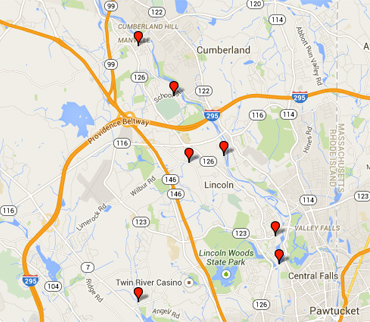
Few people vote in these elections, and in most cases fire district elections do not coincide with general elections. Lincoln also has a separate rescue service run by the town. The total per capita cost of fire and rescue protection in Lincoln is high – roughly $300. The budget for each fire district includes a proportionate share of the costs of running Lincoln's rescue service, which is operated by the town. Each of Lincoln's 6 fire districts has an elected board.
Within a 5 mile radius circle centered on downtown Pawtucket, there are 31 fire stations just on the Rhode Island side of the border. Inside of this circle sit some extremely busy fire stations and some that are not. This is a very high density of fire stations and inside of this circle some of the stations are situated just a two or three minute drive from another station.
This map shows all 31 Rhode Island fire stations that are located within 5 miles of Pawtucket.
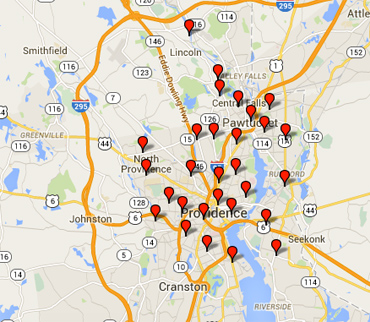
Rhode Island has more fire stations than Los Angeles (158 vs 106) or Chicago (158 vs 92). Rhode Island also has more fire engines than either city. The cost of fire protection per capita in Rhode Island is substantially higher than in any of the comparison cities on this chart. This is not an altogether fair comparison, because the land mass of Rhode Island is substantially higher than the comparison cities. We will deal with this issue at the end of the presentation.

To help illustrate the costs of redundant infrastructure in Rhode Island fire protection, we looked at what each town pays its fire chief(s) and police chief (notably, Exeter has no police force and thus no police chief). Several Rhode Island communities have multiple fire districts within their borders. Lincoln has 6 fire districts and 6 fire chiefs, and in aggregate pays those fire chiefs more than $350,000, while the single Lincoln police chief earns under $100,000. Each of those fire districts in Lincoln has to also have tax assessment infrastructure, an elected board, insurance, etc. Statewide, Rhode Island pays fire chiefs in excess of $3,500,000 per year.
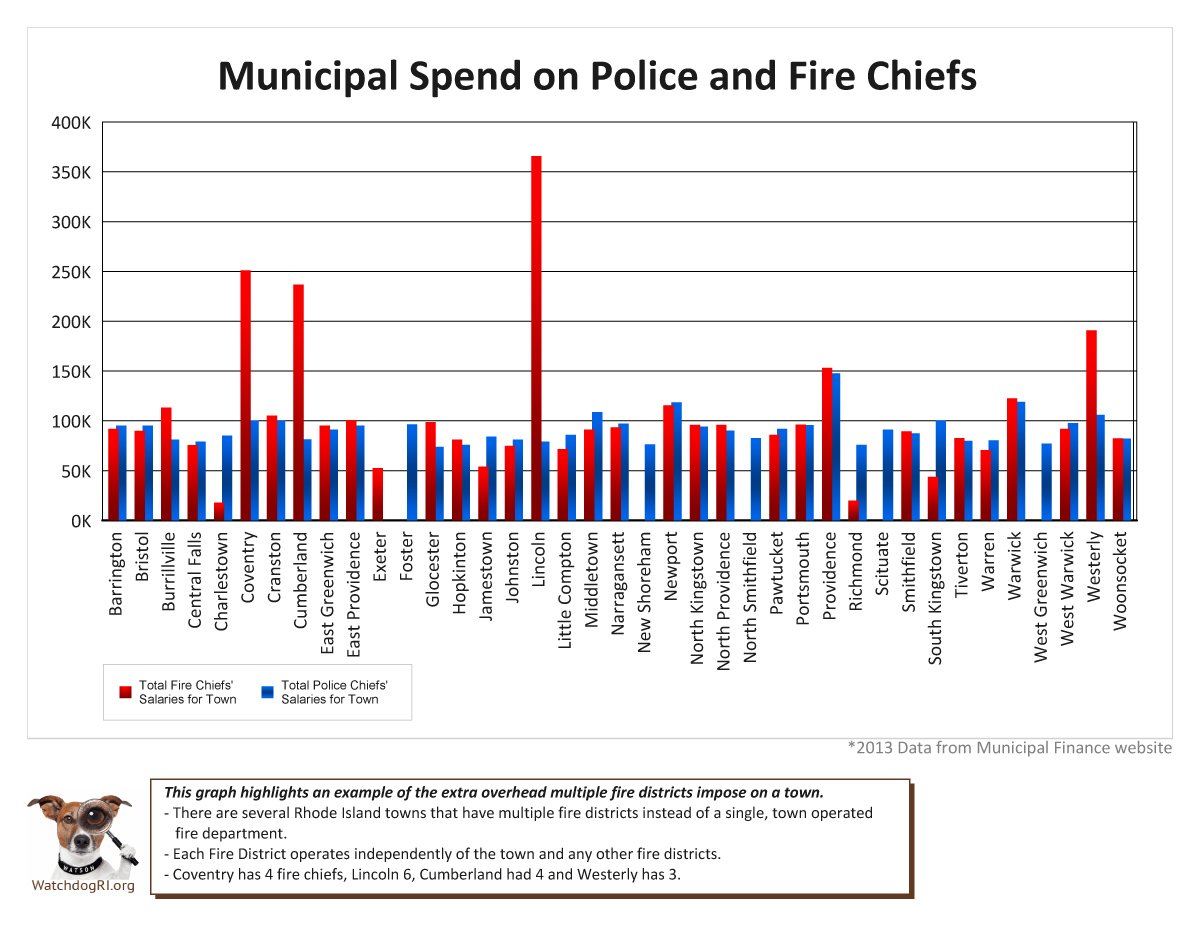
To help understand how the cost of fire protection can vary dramatically from community to community, this chart shows the cost for a family of four for fire protection in each community. The numbers on the left axis represent the per family cost for fire and rescue operations without current pension costs, while the numbers on the right axis represents the per family cost for fire and rescue operations including monies currently being paid towards pension costs. These numbers were arrived at by aggregating the costs of every fire and rescue organization within a community's borders, dividing by the number of residents in the community and multiplying by four.
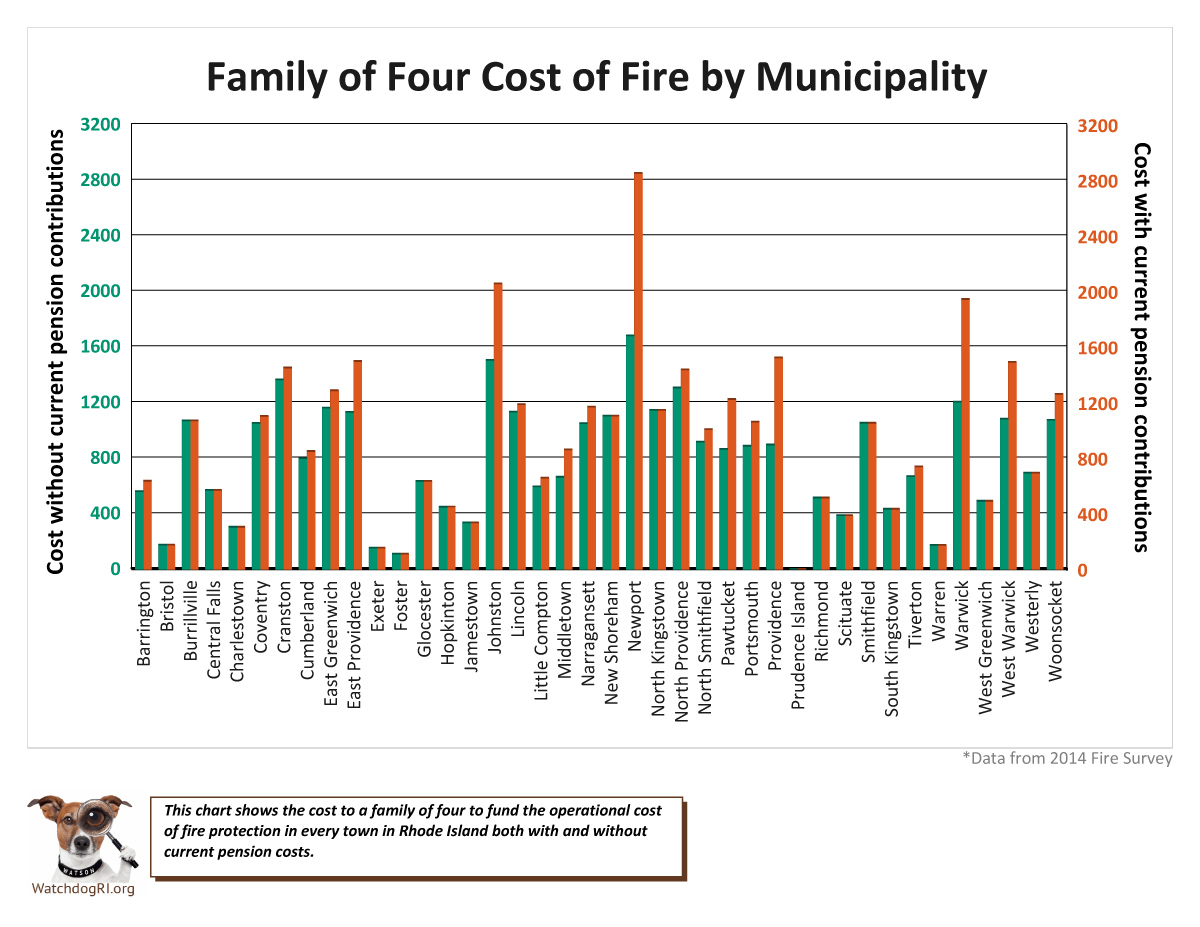
Bristol and Warren stand out in the eastern half of the state for their low cost – made possible because these towns have volunteer fire departments. Barrington has a career fire department, and is notable for its relatively low cost compared to other career departments around the state. It was more difficult to calculate the total cost of fire protection for a fire organization than you would think. For example, some municipal fire department budgets included cost elements like health insurance for fire fighters, while other departments did not.
An unfunded pension liability is defined (in an overly simplified form) as the difference between 'the amount of money a pension fund should have at this moment in time to have enough money to pay all future liabilities' minus 'the amount actually in the fund right now'. This number has to be calculated by an actuary, and it takes many complicated calculations into account to arrive at the number. Just 9 Rhode Island communities have accumulated unfunded fire fighter pension liabilities of well over $800 million. How and why this happened is outside of the scope of this first part of our research, but we hope to address it in future data releases.
Numbers on the left axis represent the unfunded pension liabilities for fire fighters for each career fire fighting organization. Numbers on the right axis represent the share of the unfunded pension liability for a family of four. While Providence has by far the highest total unfunded pension liability, the per family cost is substantially higher in several other communities, including Newport and Johnston.
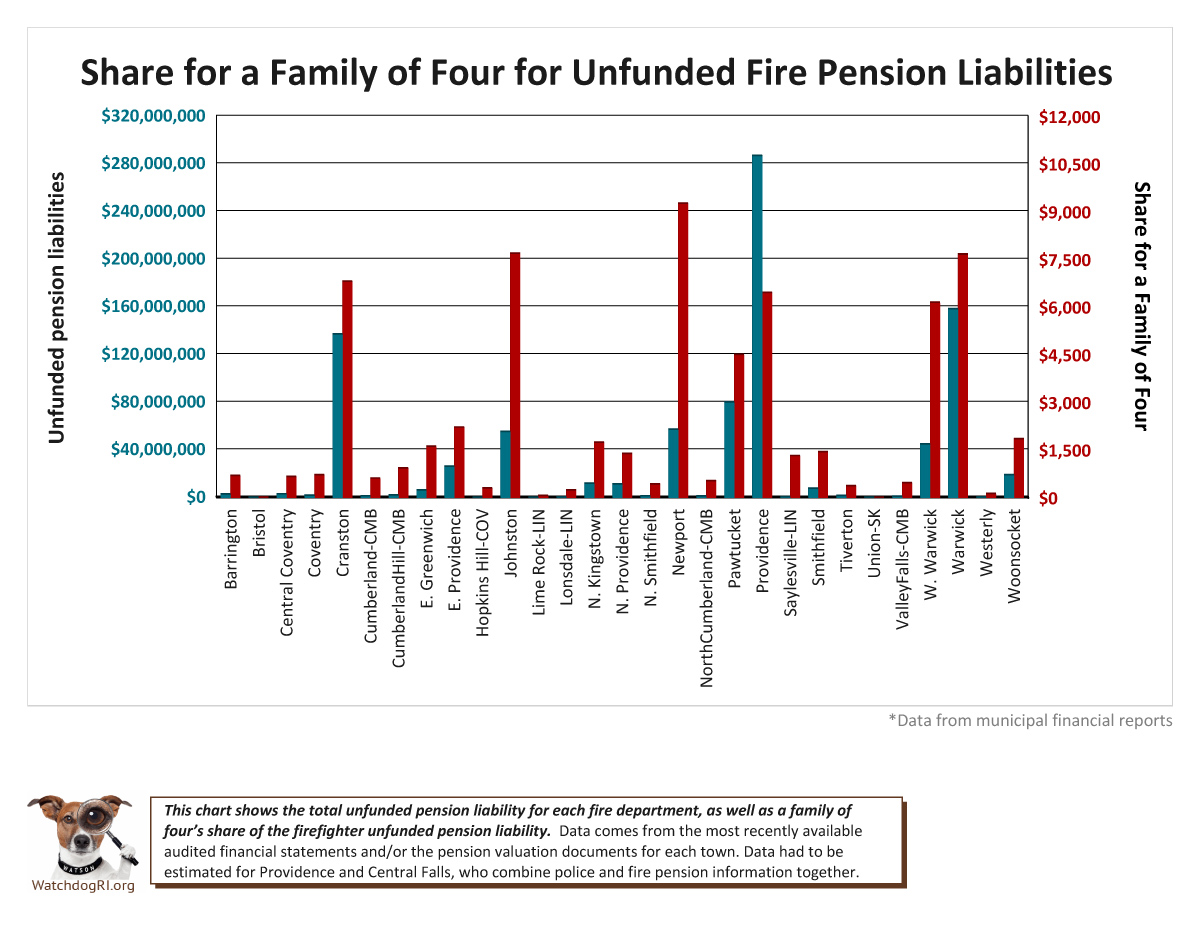
WatchdogRI.org requested the contracts for every career fire department in Rhode Island. The contracts arrived in several different forms – most of them unsearchable PDF documents. One arrived as nearly 100 printed sheets of paper. We scanned all of the contracts that arrived on paper, and converted every contract into a searchable PDF document. All of those documents are now online here (along with most police contracts, teacher contracts and municipal budgets).
Our website allows the user to search all of the contracts or budgets. This tool allows for a much simplified comparison between contracts. For example, search for the term 'clothing allowance' to see how each contract values the clothing allowances for firefighters.
You will not find the Providence firefighters' contract on our website, because the city could not provide to us a single document containing the current contract. The city sent, in response to our APRA request for the current firefighters' contract , 6 different documents going back to 1999. To piece together the contents of the current agreement, all 6 documents and many hundreds of pages must be read in the proper chronological order. The Providence firefighters' contract is the only contract we have looked at to date that is not contained in one, up to date document.
After reading the firefighters' contracts, it became clear that there were several different, complex components to a firefighter's compensation. In order to compare contracts to each other, we had to normalize the data in those contract - we had to figure out a way to compare apples to apples. We did that for this chart by converting the different forms of firefighter compensation into dollar amounts, and then added it all up. Most firefighter contracts in Rhode Island include salary, holiday pay, longevity bonus, vacation pay, sick pay, clothing allowances and incentive bonuses.
This graph depicts how each of these forms of compensation contribute to a firefighter's annual compensation for each career firefighter's contract in Rhode Island.
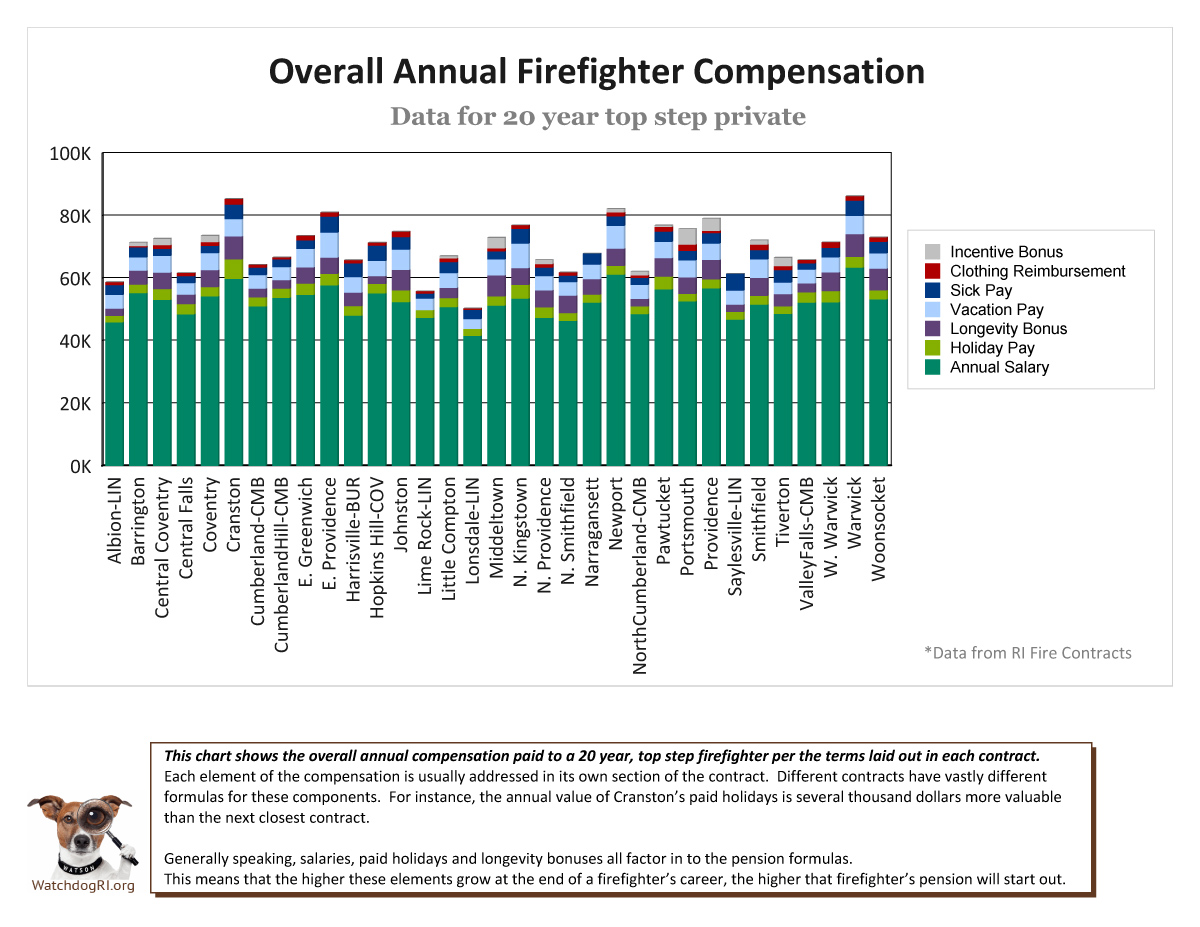
While we have comparison charts for every one of the forms of compensation found in Rhode Island firefighters' contracts, we are only including a few in this presentation.
There is tremendous variability and complexity in how the different contracts value the different compensation components. There is no better example of this than looking at what should be the simple idea of holiday pay, and how to calculate the value of that pay. Holiday pay is a basic form of compensation for firefighters. It is rolled into most pension calculation formulas.
Some contracts calculate a day of holiday pay as 1/5 of a firefighter's weekly salary, and some value that day as high as 32% of weekly salary. Some contracts peg a contract week at 42 hours, others 40. The average number of paid holidays for Rhode Island firefighters is 12.5 days. The most generous contracts provide 15 paid holidays.
Cranston stands out as an outlier relative to every other firefighting contract in the state when looking at the value of holiday pay. Cranston, along with Johnston and Pawtucket, offers 15 paid holidays. Only Cranston and Smithfield include the value of longevity bonuses in their holiday pay calculations. And only Cranston and Woonsocket provide a paid holiday in honor of 9/11 – a paid holiday that New York City firefighters do not receive.
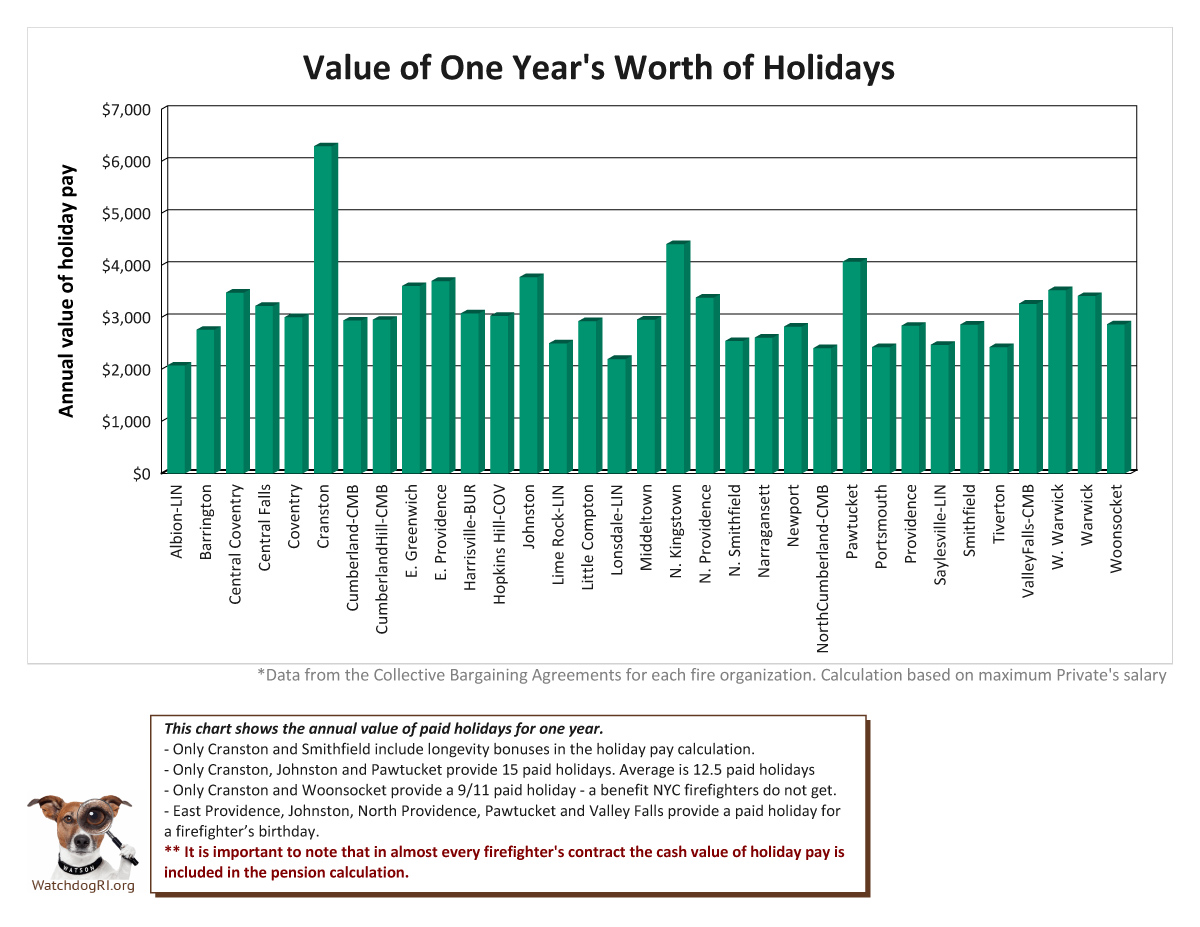
Another good example of extreme variability in contract provisions is the clothing allowance. Some contracts provide compensation for the purchase of clothing (clothing allowance) or the maintenance of clothing (clothing maintenance allowance) or both. The combined annual value of this compensation ranges from $400/year in Barrington to a high of $2,000 per year in Portsmouth.
When a municipality gets into tough financial times, the clothing allowances are often the first contract piece to be given up on a temporary basis to save money.
The Johnston contract includes the value of clothing allowances in the pension calculation formula.
We question the legality of contract provisions in the Coventry Fire District and Central Coventry Fire District that pay clothing allowance monies to firefighters outside of payroll taxes.
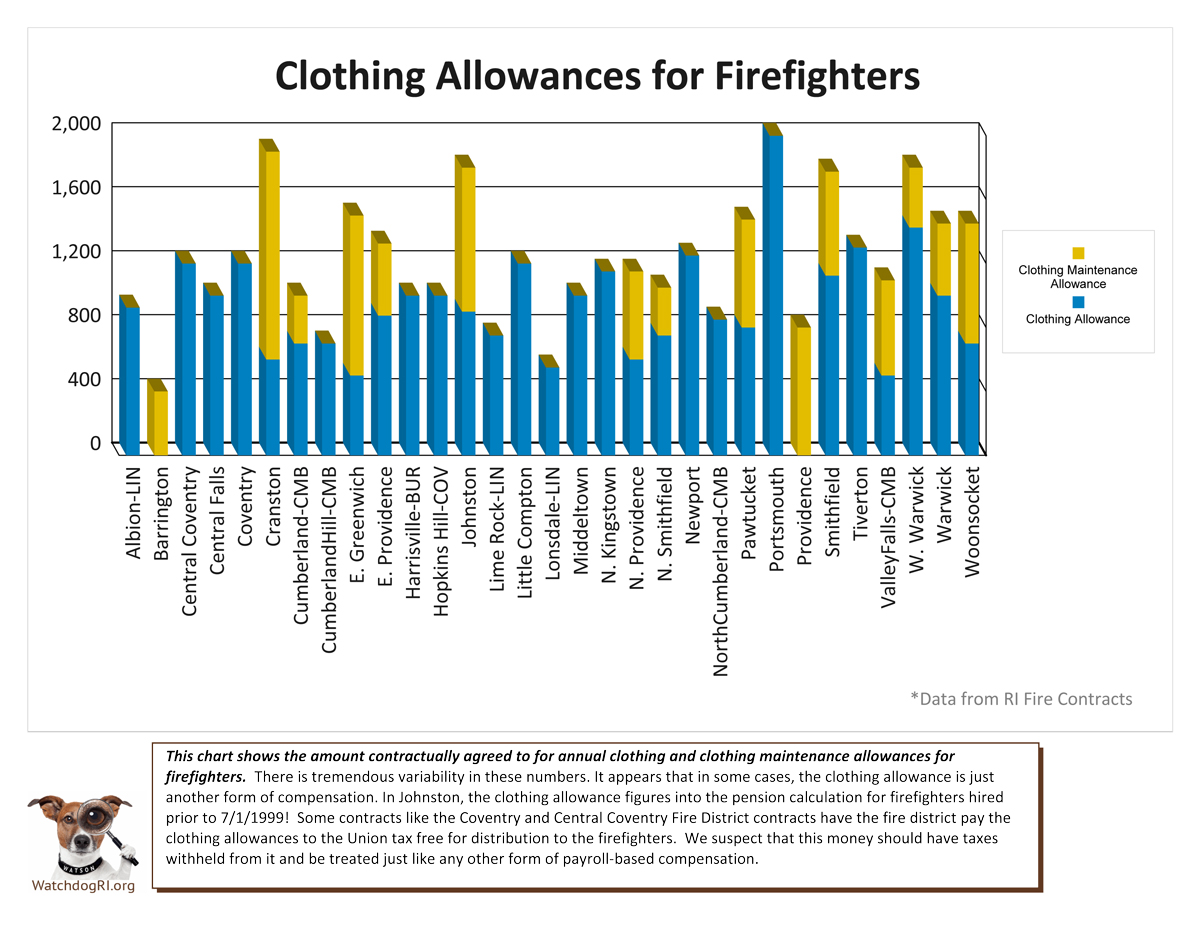
The examination of the number of disability pensions between towns yielded a few surprises. Disability pensions differ substantially from normal retirement pensions, with one of the largest factors being that the pension is distributed tax free to the recipient.
The first graph shows the total number of disability pensions by contract. While Providence and Warwick have the highest total number of disability pensions, it is notable that Cranston has far fewer disability pensions than Warwick, which is a similarly sized fire department. It was also surprising to see that Central Falls had more disability pensions than Cranston, which has a much larger firefighting department.
The largest surprise to us was the very low number of disability pensions reported in Pawtucket, which reported a single disability pension. This led us to question how that was possible, since Pawtucket, Central Falls and Providence all have similar housing stock to deal with from a firefighting perspective. One would not think that fighting fires in either Central Falls or Providence would be more dangerous or unhealthy than fighting fires in Pawtucket.
We believe that the answer to this mystery lies in the contractual language defining the qualifications to be deemed disabled for pension purposes. In Pawtucket, the contract defines disability as "total and permanent". This stands in marked contrast to other contracts such as Central Falls' contract, where hypertension is listed as a condition that qualifies for disability retirement.
Also, unfortunately, disability pension determinations can also be highly political. We have been told anecdotal stories of some mayors rewarding friends with disability pensions and removing unwanted employees from fire departments by offering disability pensions.
In Warwick, police and fire disability pensions were granted during the terms of 8 different mayors. Of the 175 active police and fire disability pensions, 45 were granted during the Flaherty years, 13 during the one Donovan term, 51 during the Walsh years, 20 during the McCaffrey years, 21 during the Chafee years, 49 during the 15 Avedisian years, 7 during Mayor Noel's terms, and 1 while Mayor Hobbs was in office.
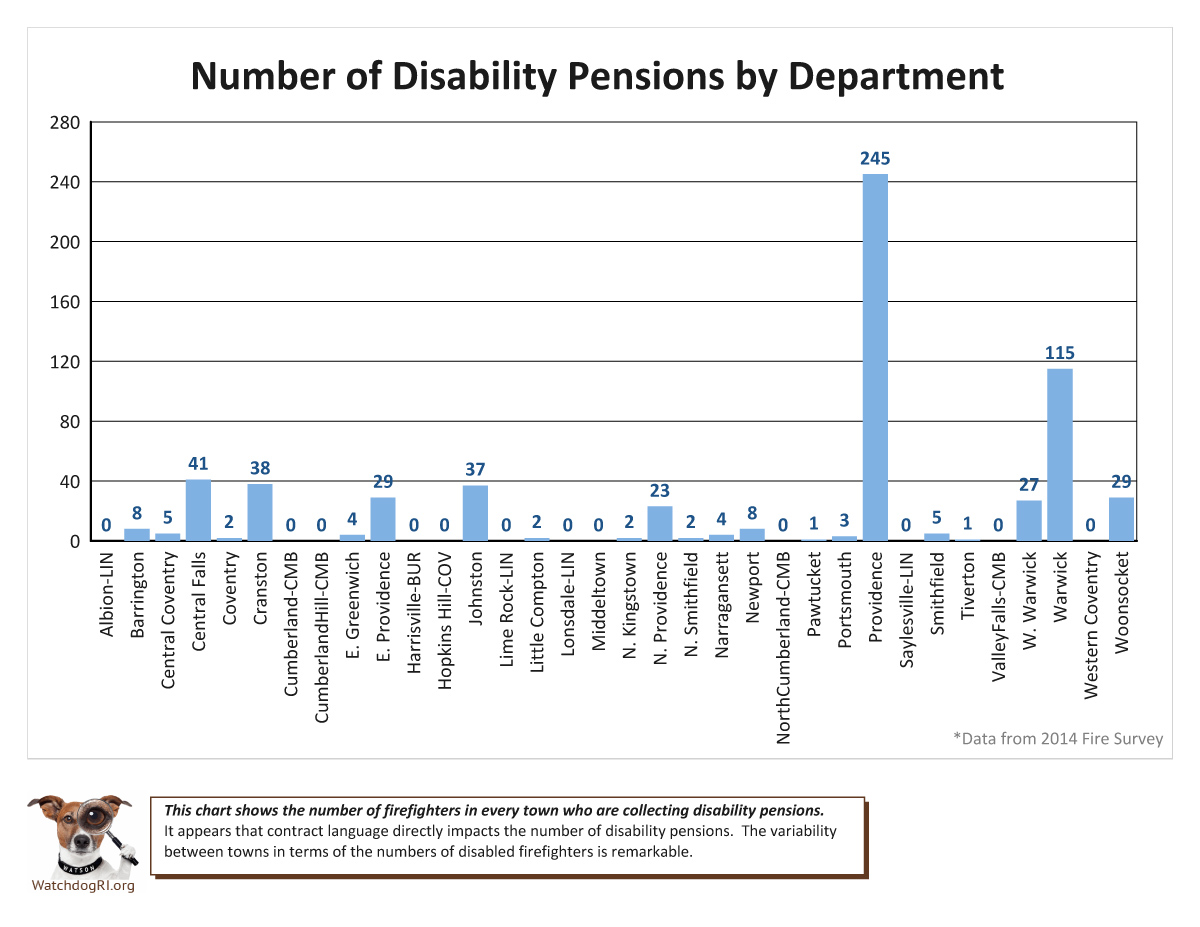
The examination of the number of disability pensions between towns yielded a few surprises. Disability pensions differ substantially from normal retirement pensions, with one of the largest factors being that the pension is distributed tax free to the recipient.
To better compare departments to each other in terms of disability pensions, this chart displays the ratio of disability pensions to the number of currently employed firefighters.
When viewed this way, it is shocking to see that Central Falls comes in at over 100%. Disability pensions is a necessary area of reform that needs to be looked at statewide in Rhode Island.
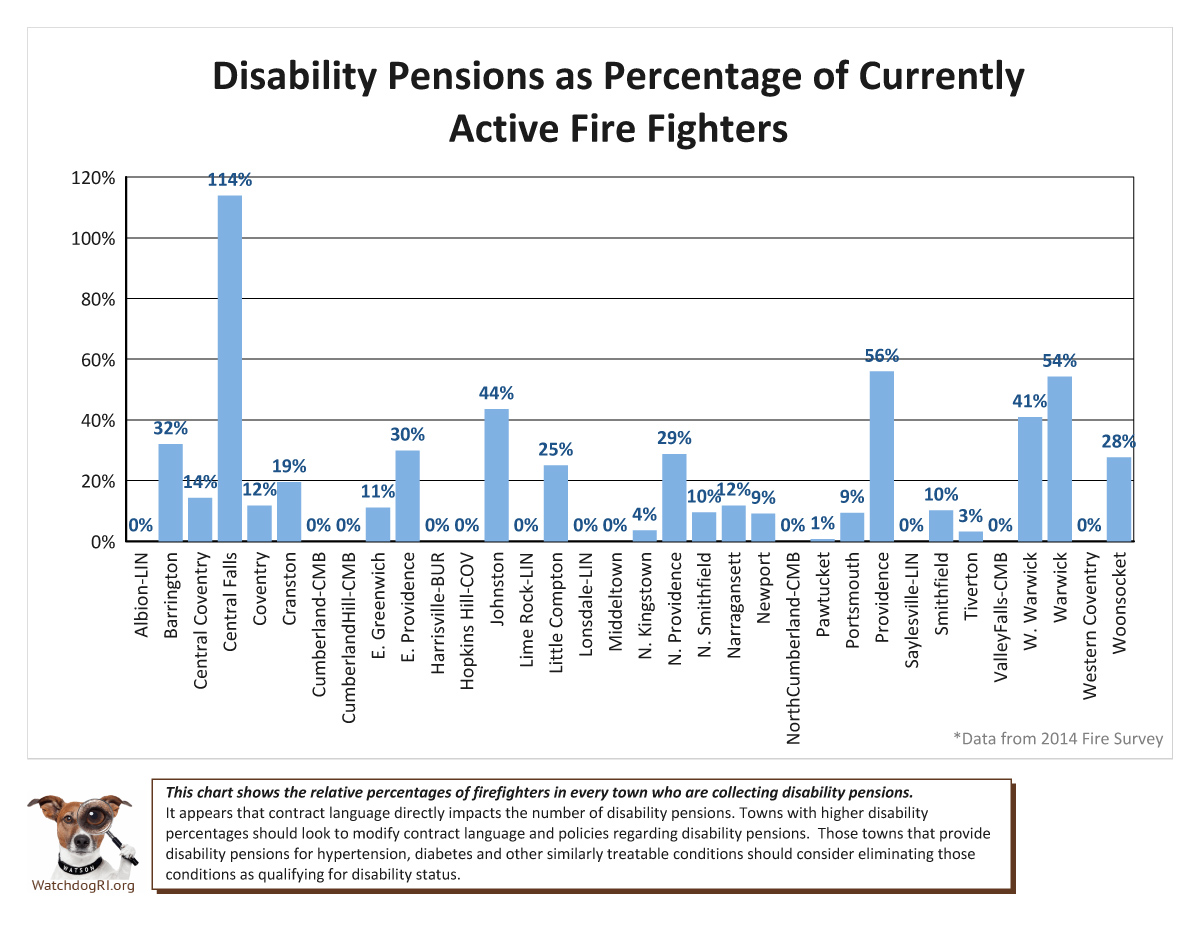
To better compare the costs of fire and rescue protection in Rhode Island with other parts of the country, we had to figure out how to compare apples to apples, which was very difficult because of Rhode Island's 1,000 square mile size. Many of the major metropolitan areas in the country are much smaller from a square mileage perspective than Rhode Island's 1,000 square miles.
It turns out that in Rhode Island, there are two very different forms of firefighting organizations. Career fire departments are mostly found in the eastern half of the state, while volunteer fire departments are largely found in the western half of the state, with the notable exceptions of the volunteer departments in Warren and Bristol.
This map divides the state roughly in half in terms of square mileage, and places most of the career fire departments in the eastern half of the state. It is the eastern half of the state, which we will now call Metro Rhode Island, that can be compared with a great many other metro areas of the country.
Metro Rhode Island contains roughly 900,000 people in about 480 square miles.
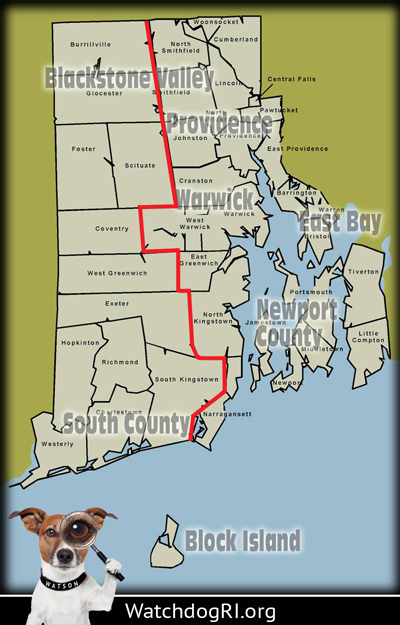
Here is a comparison of various firefighting costs and other figures for Metropolitan RI versus Western RI.
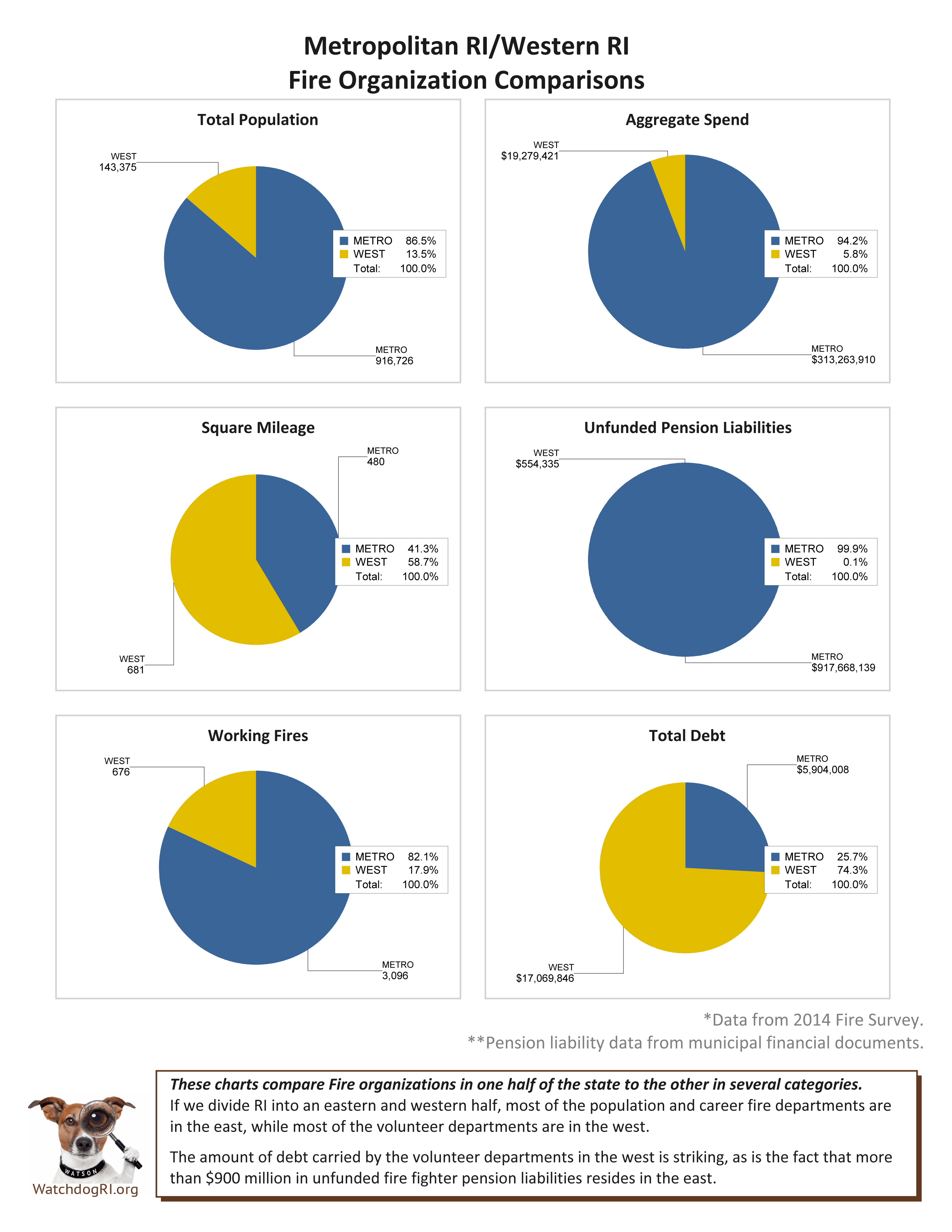
This chart compares the costs and infrastructure of fire and rescue services in Metropolitan Rhode Island to other similar areas of the country.
The number of fire stations and fire engines in Metro RI is remarkably higher than just about anywhere else in the country, and Metro RI's per capita cost of fire protection is far and away the most expensive that we have seen in the country.
While there are many drivers of cost in fire protection, the amount of stations and apparatus is certainly a big factor in that cost. Many of Rhode Island's fire stations were placed in the spot they are in now as long as a century or more ago, when fire trucks were pulled by men or horses. We believe that these comparative numbers prove that a statewide, comprehensive look at where RI's fire stations need to be and how many and what type of apparatus is required needs to be performed.
The fact that Metro Rhode Island has nearly as many fire stations, fire engines and ladder trucks as the Dallas and Phoenix fire departments combined is a strong signal that we might very well be over equipped.
Rhode Island's huge unfunded firefighter pension liability threatens a dozen RI communities with financial disaster. While it is true that 'kick the can down the road' elected officials in many of these communities have not made pension payments in the past – equally reckless elected officials negotiated pension clauses that were unsustainable, spiking salaries at the end of firefighter careers and allowing for things like overtime to be factored into the pension amount.
The RI communities with large unfunded pension liability problems need to come together with firefighter unions and retirees to work out a resolution to this problem. It is manifestly unfair that promises made by negotiators on both sides decades ago now threaten the financial futures of today's children in those communities. We believe that both sides of the negotiations can share in the blame for this problem – and that our children unfairly are left with the job of trying to clean it up. WatchdogRI.org will produce a follow up report that is devoted to the pension issue, as this issue is large enough and critical enough to deserve its own report.
RI should take care to feed and nourish its volunteer fire departments. It is crystal clear that nationally, large departments with a mix of career and volunteer firefighters are by far the most cost effective form of fire protection.
